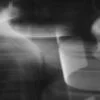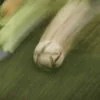It is at those points where the skin is thinnest and most quickly oxidised – the forehead, the ankles, the hips – where fire will first expose the underlying bone. The head burns from the crown to the nape, for instance, from the thinnest flesh to the thickest. The skin tightens and splits to expose fat, tendons, ligaments, organs and bones. With the protective dermis gone, fat renders and becomes a secondary accelerant. Bone turns yellow, then black, then white, finally grey. Ninety minutes have passed. The gas is switched off, the cremator cools, a technician gets to work with a rake.
You’d rather the alternative? Once blood has ceased to transport oxygen through the circulatory system, cells die and discharge digestive enzymes, breaking down the body’s soft tissues. The stomach, groin and limbs bloat, then, after a week or so – deflate. The skin discolours, sloughs. First to decompose is the head flesh, the eyes, ears and nose. Upper limbs before lower. The stomach, spleen and intestines go relatively quickly; the kidneys, heart and liver are more enduring. One by one the joints disarticulate. After eighteen months, little remains in most cases but a set of greasy bones in a cake of hard-set fluid. The body has begun its migration out into the world.
Over the course of human history most human corpses, 100 billion or more, have been either cremated or buried. Even the least conventional of us, or the least religious, might be forgiven for feeling discomfited about having to consider a third option after all this time, all these generations. We might wonder what it means for the dying and for the dead, and not only them.
Elizabeth Oakes’s Resomarium, in the town of Navan, about twenty-seven miles north-west of Dublin, is leased from an adjoining firm of funeral directors, James Fox, which in turn is attached, as such businesses often are in Ireland, to a pub, Fox’s Bar and Lounge. There is a mural of a fox and hounds but no obvious signage to indicate the premises of Oakes’s company, Pure Reflections, where I spent a morning in early December. In addition to Oakes’s desk there were in her office an empty wicker casket on a bier and, on the windowsill, three droplet-shaped ceramic urns. Otherwise the room was almost bare. From the next room, however, I felt a force, something akin to gravity. It was strange to think that the machine was just behind that locked door, in this ancient town on the confluence of the rivers Boyne and Blackwater. But then doesn’t the Large Hadron Collider lie beneath fields of French cows?
The first thing I saw when Oakes took me through was a coffin. The second was the Resomator S750, a sculpted monolith of stainless steel, at once industrial and clinical, and thus inherently terrifying. It was the size of a horse box, with a massive-hinged circular door like a submarine hatch. (A submarine hatch is precisely what it was.) It resembled something from a prison kitchen or a milking shed. The prone body, Oakes explained, would be hoisted from the coffin and slid into the unit head-first before the hatch was swung shut. With a fingertip you tap in the body’s characteristics – weight, height, sex, embalmed, un-embalmed – and the computer calculates the right volumes of water and chemical. The vessel fills with water until the body is covered. The requisite dose of potassium hydroxide, usually about 5 per cent, is added, and a heat-exchanger – a metal coil snaking under the corpse-tray – heats the mixture until, after an hour or so, the machine’s working temperature of 150°C has been achieved. The ‘Resomation phase’ initiates.
The chemical term for the process is alkaline hydrolysis. ‘Hydrolysis’ describes the destruction of chemical bonds by the insertion of a water molecule. In alkaline hydrolysis, an alkali operates as a catalyst, increasing the rate of reaction. The effect, in combination with heat and agitation, is to reduce biological material to a sterile solution. This includes proteins, carbohydrates and lipids, as well as deoxyribonucleic acid, or DNA. For an hour or two (more, if the body is big, or drenched in embalmers’ formaldehyde), the fluid is recirculated via a network of spigots. Outside, all that is audible is a muffled sloshing, like a high-end dishwasher, and the occasional pneumatic phut of solenoid valves opening or closing. After an hour or two the agitation ceases, the bath stills, the unit is cooled with a cold spray, the fluid or hydrolosate – 1,500 litres resembling weak black tea – drains away to be neutralised in a separate tank. And with a thunk-hush and an exhalation of steam, the submarine door unlatches. All that remains, across the bottom of the unit, are the bones and teeth. Once dried and ground up (about twenty seconds in Oakes’s cremulator, the same machine used in cremation), these resemble not ashes – the gritty tephra I scattered in those Hampshire woods – but something much cleaner and more homogenous, a white powder fine as talc.


Sign in to Granta.com.







